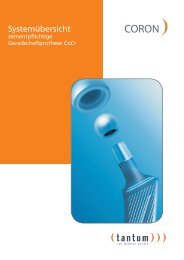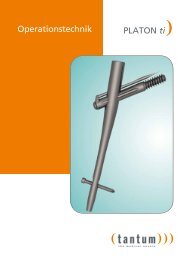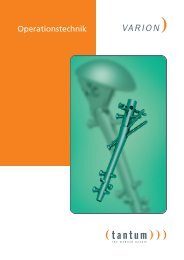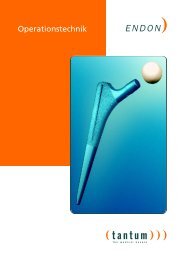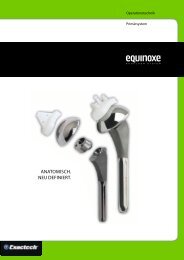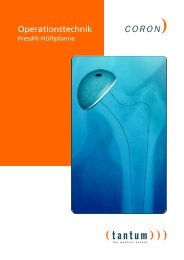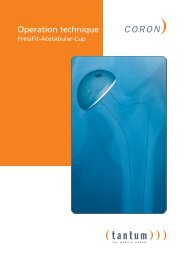PLATON-Locking-Nail-System - tantum AG
PLATON-Locking-Nail-System - tantum AG
PLATON-Locking-Nail-System - tantum AG
You also want an ePaper? Increase the reach of your titles
YUMPU automatically turns print PDFs into web optimized ePapers that Google loves.
14. Removal of the Implants<br />
1. Removal of the distal <strong>Locking</strong> Screw<br />
Excision of the old scar,<br />
locating the screw head. Fig.35<br />
Palpation of the exact<br />
position is then followed<br />
by incision and exposure.<br />
Removal of the distal<br />
<strong>Locking</strong> Screw with the<br />
Screwdriver SW 5 (Art.<br />
No. 201-100 or Art. No 201-102) (Fig. 35).<br />
Excision of the upper scar.<br />
Splitting of the aponeurosis and<br />
blunt preparation up to the tip<br />
of the greater trochanter.<br />
Exposure of the proximal nail<br />
end. Removal of the Proximal<br />
Plug with the Universal Joint<br />
Screwdriver (Art. No. 201-110)<br />
and Screwdriver Bit SW 4 (Art.<br />
No. 201-120) (Fig. 36).<br />
2. Removal of the Proximal Plug or the Fixation Bolt<br />
Fig.36<br />
Excision of the middle<br />
scar, splitting the fascia<br />
and exposure of the<br />
lateral end of the Femoral<br />
Lag Screw (optionally<br />
with the help of the<br />
3. Removal of Cap Screw or the AR-Clip<br />
image intensifier).<br />
The insertion of a Guide<br />
Wire (Art. No. 206-100)<br />
into the Femoral Lag<br />
Screw can be helpful.<br />
Fig.37<br />
Fig.38<br />
The Cap Screw is extracted<br />
with the screwdriver<br />
(Art. No. 201-100) (Fig. 37).<br />
If an AR-Clip is implanted,<br />
it should be removed<br />
prior to the lag<br />
screw. For easier location of the screw head the Guide<br />
Guide Wire (Art. No. 206-100) or a K-wire should be<br />
inserted through the connecting screw (Art. No. 100-304).<br />
driver<br />
Next,<br />
(Art.<br />
the connecting<br />
No. 201-100)<br />
screw<br />
(Fig. 38).<br />
is removed<br />
The Clip with<br />
with<br />
the<br />
the<br />
screwed<br />
Screw-<br />
on Lag Screw Inserter<br />
(Art. No 201-131) is also<br />
removed. For removal of<br />
the Clip a Kocher clamp<br />
or similar can be used<br />
alternatively.<br />
If the Femoral Lag Screw<br />
does not take hold when<br />
loosening the connecting screw, the Femoral Lag Screw<br />
4. Removal of the Femoral Lag Screw<br />
The Lag screw inserter is<br />
connected to the Femoral<br />
Femoral Lag Screw.<br />
Lag Screw (Fig. 40)<br />
and the Femoral Lag<br />
Screw can be removed.<br />
Fig.39<br />
can be arrested temporary by using a 2mm Kirschner<br />
wire inserted through the small hole in the Clip.<br />
5. Removal of the <strong>PLATON</strong>-<strong>Nail</strong><br />
Fig.40<br />
In order to remove the <strong>Nail</strong>, the Extraction Adapter<br />
(Art. No. 205-105) is screwed into the <strong>Nail</strong>. The<br />
Extraction Rod (Art. No. 205-115) is connected to the<br />
extraction rod handle (Art.-No. 205-125) and the impaction<br />
weight (Art. No. 205-120). The Extraction Rod is then<br />
screwed onto the Extraction Adapter and tightened<br />
with the Wrench (Art.-No. 201-140). The <strong>Nail</strong> is then<br />
carefully extracted (Fig. 41).<br />
Note: If problems occur with<br />
exact insertion of the Extraction<br />
Adapter, the <strong>Nail</strong> can be removed<br />
alternatively with the Femoral Lag<br />
Screw and the screwed on Lag<br />
Screw Inserter. The screw is then<br />
driven into the proximal nail end<br />
until it is locked in the thread.<br />
Now the <strong>Nail</strong> can easily be remo-<br />
ved.<br />
Fig.41<br />
19



